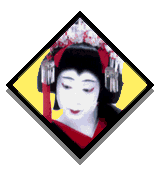

Unit 7

English 203:
Literature of the NonWestern World
 |

Unit 7 |

English 203: Literature of the NonWestern World |
| Introduction | .Explication | Questions | Review |
Reading:
Basho, 2108-34
Kojima Nobuo, 2893-2919
Introduction:
Basho: (The Banana Tree):
Religious pilgrimages
cause many of us to think of Islam with the haj to Mecca or perhaps
medieval Europe with Chaucer's Canterbury Tales. It also makes
me think of Easter in New Mexico when thousands walk the highways to reach
the tiny church at Chimayo.
| Chimayo |
Basho was a dedicated Buddhist. His journal is not a travelogue. It offers illustration of Buddhist principles, especially of the 3 basic truths about reality:
Anicca: the universe (or God) is a verb, not a noun. Because it is a process, no shape or form or noun persists indefinitely. Life is a journey, a pilgrimage. The destination hardly matters.Anatta: change/process includes you. You are not exempt for the process of change. You have no single, ahistorical identity (no soul, no ego) that can persist for long. You are a traveler through life without permanent attachments of any kind. You have no home, no relatives. You "have" perceptions; or rather you are a temporal series of perceptions.Dukkha: in our deluded state we believe that our ego is stable & exempt from change & that it can possess relationships, money, experiences, etc. for eternity. Because this is impossible, we experience life as disappointing, as suffering. The pattern of Basho's journey is a struggle to reach some religious or cultural site only to find that it is lost, forgotten, & eroded by time: "We hear about many places celebrated in verse since antiquity, most of them have vanished with the passing of time" (2120). You cannot reach any stable, sheltered place or goal in this world governed by anicca.
The Japanese synonym for dukkha is sabi, which also means loneliness, disappointment, emptiness. Japanese literary art, especially poetry, is often dedicated to producing this feeling. Why? Because the Japanese are Buddhist & as such they understand that this is the human condition or the condition of unenlightened life. Many poems by Basho's evoke sabi.
Kojima Nobuo:
The theme of this story is pretty obvious: how can Japan "walk" (cf. walking the path of Dao) after the defeat of WW2 & the American occupation? This is not a classic story of colonialism. The Nigerian writer, Chinua Achebe, will present that paradigm in his novel Things Fall Apart. Kojima illustrates the Japanese experience, not of colonization, but occupation for a few years after the military defeat of 1945. The most obvious similarity is the feeling that one's indigenous culture has failed & is judged to be inadequate by the conquerors. Military tactics have failed the Japanese. Consequently Nobuo's characters feel that it is futile to resist the foreigners directly or violently. The Japanese have to somehow "walk" the American road even in high heels or barefoot & blistered.
Kojima's story is representative of a historic concern in Japan that dated from the middle of the 19th c. when the American Admiral Perry "opened" Japan to the world by military intimidation. Japan's great writers of the last century frequently pursued the theme of "what makes us Japanese" or "what does it mean to be Japanese."
Click on the next section:
| Explication |